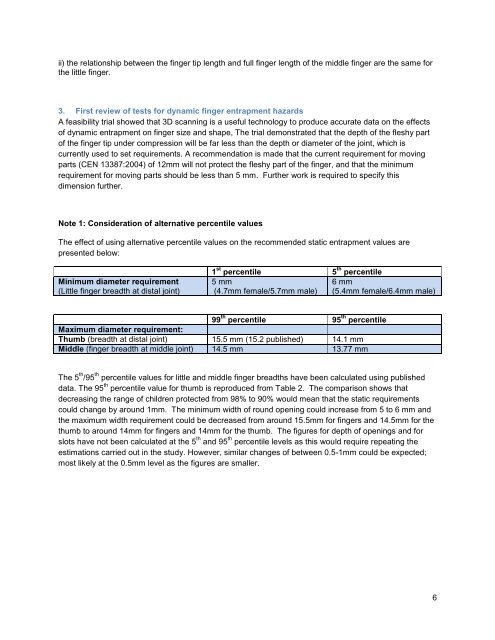Requirements for finger entrapment in European safety ... - ANEC
Requirements for finger entrapment in European safety ... - ANEC
Requirements for finger entrapment in European safety ... - ANEC
You also want an ePaper? Increase the reach of your titles
YUMPU automatically turns print PDFs into web optimized ePapers that Google loves.
ii) the relationship between the <strong>f<strong>in</strong>ger</strong> tip length and full <strong>f<strong>in</strong>ger</strong> length of the middle <strong>f<strong>in</strong>ger</strong> are the same <strong>for</strong><br />
the little <strong>f<strong>in</strong>ger</strong>.<br />
3. First review of tests <strong>for</strong> dynamic <strong>f<strong>in</strong>ger</strong> <strong>entrapment</strong> hazards<br />
A feasibility trial showed that 3D scann<strong>in</strong>g is a useful technology to produce accurate data on the effects<br />
of dynamic <strong>entrapment</strong> on <strong>f<strong>in</strong>ger</strong> size and shape, The trial demonstrated that the depth of the fleshy part<br />
of the <strong>f<strong>in</strong>ger</strong> tip under compression will be far less than the depth or diameter of the jo<strong>in</strong>t, which is<br />
currently used to set requirements. A recommendation is made that the current requirement <strong>for</strong> mov<strong>in</strong>g<br />
parts (CEN 13387:2004) of 12mm will not protect the fleshy part of the <strong>f<strong>in</strong>ger</strong>, and that the m<strong>in</strong>imum<br />
requirement <strong>for</strong> mov<strong>in</strong>g parts should be less than 5 mm. Further work is required to specify this<br />
dimension further.<br />
Note 1: Consideration of alternative percentile values<br />
The effect of us<strong>in</strong>g alternative percentile values on the recommended static <strong>entrapment</strong> values are<br />
presented below:<br />
M<strong>in</strong>imum diameter requirement<br />
(Little <strong>f<strong>in</strong>ger</strong> breadth at distal jo<strong>in</strong>t)<br />
1 st percentile 5 th percentile<br />
5 mm<br />
6 mm<br />
(4.7mm female/5.7mm male) (5.4mm female/6.4mm male)<br />
99 th percentile 95 th percentile<br />
Maximum diameter requirement:<br />
Thumb (breadth at distal jo<strong>in</strong>t) 15.5 mm (15.2 published) 14.1 mm<br />
Middle (<strong>f<strong>in</strong>ger</strong> breadth at middle jo<strong>in</strong>t) 14.5 mm 13.77 mm<br />
The 5 th /95 th percentile values <strong>for</strong> little and middle <strong>f<strong>in</strong>ger</strong> breadths have been calculated us<strong>in</strong>g published<br />
data. The 95 th percentile value <strong>for</strong> thumb is reproduced from Table 2. The comparison shows that<br />
decreas<strong>in</strong>g the range of children protected from 98% to 90% would mean that the static requirements<br />
could change by around 1mm. The m<strong>in</strong>imum width of round open<strong>in</strong>g could <strong>in</strong>crease from 5 to 6 mm and<br />
the maximum width requirement could be decreased from around 15.5mm <strong>for</strong> <strong>f<strong>in</strong>ger</strong>s and 14.5mm <strong>for</strong> the<br />
thumb to around 14mm <strong>for</strong> <strong>f<strong>in</strong>ger</strong>s and 14mm <strong>for</strong> the thumb. The figures <strong>for</strong> depth of open<strong>in</strong>gs and <strong>for</strong><br />
slots have not been calculated at the 5 th and 95 th percentile levels as this would require repeat<strong>in</strong>g the<br />
estimations carried out <strong>in</strong> the study. However, similar changes of between 0.5-1mm could be expected;<br />
most likely at the 0.5mm level as the figures are smaller.<br />
6
















